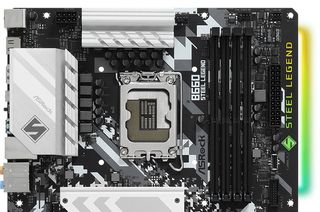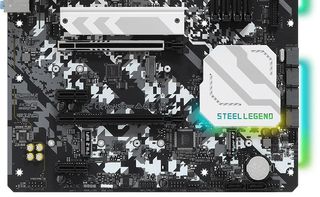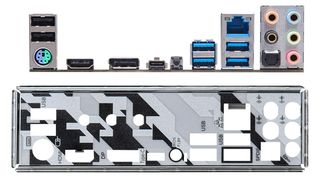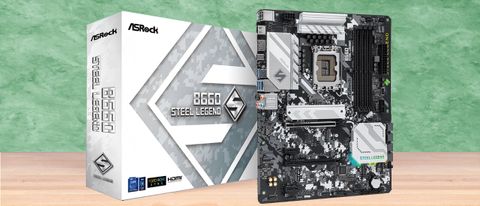Tom's Hardware Verdict
At $159.99, the B660 Steel Legend is priced right and comes with a feature set comparable to the competition, including multiple M.2 sockets, a USB 3.2 Gen 2x2 port, and some bright RGB lighting. Performance was off in some heavily multi-threaded tests due to thermal throttling, but a simple voltage adjustment should mitigate this concern, as would running a lesser processor.
Pros
- +
+ Low price
- +
+ Bright RGB lighting
- +
+ USB 3.2 Gen 2x2 Type-C front port
Cons
- -
Paltry power delivery
- -
Lower USB count on rear IO
- -
Hot running VRMs
Why you can trust Tom's Hardware
Unlike the flagship or halo-cass Intel boards we’ve tested recently, ASRock’s B660 Steel Legend is an inexpensive option Alder Lake-based processors. It covers all of the basics, including a PCIe 5.0 slot for graphics, three M.2 sockets, six SATA ports, M.2 Key-E slot to add Wi-Fi, brilliant RGB LED lighting, and more for $159.99. While it doesn’t offer high-end features (which no one expects at this price point), it’s still plenty capable for users not looking to pay a premium for features or speeds they can’t or won’t utilize.
For just under $160, you get a black, white and silver appearance that should fit with many build themes. While the motherboard’s PCB is mostly exposed (you won’t find heatsinks and shrouds covering things at this price point), ASRock added some black, white and gray design elements that almost look like camouflage. The Steel Legend includes 10-phase power delivery, with 9 phases dedicated to the CPU(Vcore). Although it isn’t the most robust we’ve seen, we didn’t notice throttling due to the warm VRM temps. Still, it did struggle performance-wise with some heavily multithreaded loads. The processor temperature casued thermal throttling due to voltage used by default. In short, performance is good when you’re not loading this CPU up with all cores and threads, but struggles with our Core i9-12900K otherwise. Consider using a lesser CPU with this board, or adjusting the voltage (which we’ll discuss later).
Speaking of performance, the B660 Steel Legend was all over the place, depending on the tests. For example, in the Procyon tests, specifically the MS Office sub-tests, it was one of the fastest boards overall. In other tests, including 7Zip, Cinebench(multi-core), POV-Ray (multi-core), and Handbrake decoding, it was one of the slower boards tested. AIDA64’s bandwidth tests also show the Steel Legend a bit slower than the other like boards. On the other hand, gaming results were spot on and in the ballpark of other DDR4-based systems. Power use was on the lower side of average (lower is better), at both idle and load.
Below, we’ll look at the B660 Steel Legend’s features, performance, and software to determine if this budget-class motherboard is worth considering compared to Z690 and other B660 boards. Is it worthy of a spot on our best motherboards list? Before we figure that out, below is a detailed list of the Steel Legend’s specs, direct from ASRock.
Specifications: ASRock B660 Steel Legend
| Socket | LGA1700 |
| Chipset | B660 |
| Form Factor | ATX |
| Voltage Regulator | 10 Phase (9 50A DrMOS MOSFETs for Vcore) |
| Video Ports | (1) HDMI (v2.1) |
| Row 5 - Cell 0 | (1) DisplayPort (v1.4) |
| USB Ports | (1) USB 3.2 Gen 2 Type-C (10 Gbps) |
| Row 7 - Cell 0 | (4) USB 3.2 Gen 1 Type-C (5 Gbps) |
| Row 8 - Cell 0 | (2) USB 2.0 (480 Mbps) |
| Network Jacks | (1) 2.5 GbE |
| Audio Jacks | (5) Analog + SPDIF |
| Legacy Ports/Jacks | (1) PS/2 port (mouse/keyboard) |
| Other Ports/Jack | ✗ |
| PCIe x16 | (1) v5.0 (x16) |
| Row 14 - Cell 0 | (1) v4.0 (x2) |
| PCIe x8 | ✗ |
| PCIe x4 | ✗ |
| PCIe x1 | (2) v3.0 (x1) |
| CrossFire/SLI | ✗ |
| DIMM slots | (2) DDR4 5333+(OC), 128GB Capacity |
| M.2 slots | (1) PCIe 4.0 x4 (64 Gbps), PCIe (up to 80mm) |
| Row 21 - Cell 0 | (1) PCIe 4.0 x4 (64 Gbps), PCIe (up to 110mm) |
| Row 22 - Cell 0 | (1) PCIe 3.0 x2 (16 Gbps), PCIe/SATA (up to 110mm) |
| U.2 Ports | ✗ |
| SATA Ports | (6) SATA3 6 Gbps (Supports RAID 0/1/5/10) |
| USB Headers | (1) USB v3.2 Gen 2x2, Type-C (20 Gbps) |
| Row 26 - Cell 0 | (1) USB v3.2 Gen 1 (5 Gbps) |
| Row 27 - Cell 0 | (1) USB v2.0 (480 Mbps) |
| Fan/Pump Headers | (7) 4-Pin (CPU Fan, CPU/Water Pump Fan, Chassis/Water Pump) |
| RGB Headers | (3) aRGB (3-pin) |
| Row 30 - Cell 0 | (1) RGB (4-pin) |
| Diagnostics Panel | 4-LED POST Status Checker |
| Internal Button/Switch | ✗ |
| SATA Controllers | ASMedia ASM1061 |
| Ethernet Controller(s) | Realtek RTL8125GB (2.5 Gbps) |
| Wi-Fi / Bluetooth | ✗ |
| USB Controllers | USB Controllers |
| HD Audio Codec | Realtek ALC897 |
| DDL/DTS | ✗ / ✗ |
| Warranty | 3 Years |
Inside the Box of the ASRock B660 Steel Legend
Inside the box, along with the motherboard, ASRock gives users the most basic of basic accessory stacks. You’ll find SATA cables and screws/standoffs for M.2 sockets. That’s it outside of the guides, the IO shield you need to install, and a driver CD. Here’s a full list.
- (2) SATA cables
- (4) M.2 screws
- M.2 standoff
- Rear IO shield
- Installation Guide
- Driver CD
Design of the ASRock B660 Steel Legend



Taking a look at the board, we’re greeted by a 6-layer jet black PCB with some black, white, and grey design elements that closely resemble digitized camouflage. ASRock uses silver heatsinks for the power delivery, primary M.2 socket, and the chipset which. This is a nice contrast to the other colors. There’s a fair amount of surface area on the VRM heatsinks, though they lack significant mass. You’ll find the ASRock branding and the Steel Legend “S” symbol on the left VRM heatsink, while the chipset heatsink sports the Steel Legend name with RGB lighting shining through from below.
Speaking of RGBs, the Steel Legend not only lights up the chipset heatsink, but there are also several RGB LEDs hidden under the right edge of the board. At the top, they shine through the motherboard, highlighting more Steel Legend branding, while under the SATA ports is yet another set of RGB LEDs. The Steel Legend’s appearance is fairly busy with all of the stenciling and designs, but still looks good compared to similarly priced options. It may not be the star of your build, but it won’t take away from most build themes either.

Focusing on the top half of the board, we get a better look at the heatsinks, designs, and other things going on in this area. Above the VRM heatsinks, we spy a single 8-pin EPS (required) to power the CPU. You typically don’t see dual EPS connectors on this class of board as there simply isn’t a need when the chipset can’t overclock the processor in the first place.
Just to the right of the top heatsink are the first (of seven) 4-pin fan/pump headers. All headers support both PWM and DC-controlled devices. CPU_FAN2/WP and CHA_FAN1-5/WP auto-detect if a 3-pin or 4-pin fan is used. The CPU Fan connector supports up to 1A/12W, while the rest support 2A/24W. There’s plenty of power for fans and most pumps in this configuration. As always, be sure to check the power requirements of the equipment you plan to use.
Next, we run into four single-side locking, unreinforced DDR4 DRAM slots. ASRock lists support up to DDR4 5333+(OC), but as usual, your mileage may vary. Reaching these speeds depends on the kit used and the quality of your CPU’s integrated memory controller (IMD). Typically, reaching these speeds is done with only one stick anyway. That said, we didn’t have any issues with either of our test kits.
Along the top-right edge, above the DRAM slots, are two more fan headers. Typically, you find the ATX power connector and USB headers (in this case, 3.2 Gen 2x2 Type-C and 3.2 Gen 1) in this area, but ASRock chose to use an aesthetic feature in that space and offset the connectors around about three-forths of an inch toward the socket/middle of the board. Under this free space are two LED strips, both of which are controlled by the the company’s Polychrome Sync software. The bright LEDs shine through the translucent Steel Legend branding, giving it a unique look. If you don’t like the bright lights, they are easily disabled in the BIOS or software.

Focusing on the VRMs, ASRock implemented a 10-phase power delivery model, with nine phases dedicated to the CPU/Vcore. The 8-pin EPS connector sends power to a Realtek RT3628AE 9-channel controller, sending power directly to the 50A Vishay Sic654 DrMOS integrated power stages. The 450A available to Vcore is much lower than what we’re used to, but we need to remember that B660 boards cannot overclock the CPU, so it only has to support Intel’s stock configuration. We didn’t have any issues concerning throttling of the VRMs, but did from the temperature of the CPU during heavily multi-threaded benchmarks and stress tests (more on that later).

On the bottom half of the board, we see a lot of PCB, exposing nearly all of the slots and sockets available. On the left is the dated Realtek ALC897 audio codec and four gold Nichicon audio caps. The audio solution may not please an audiophile with a discerning ear and a high-quality set of speakers/headphones, but the basic audio solution will be perfectly acceptable for most. And a true audiophile will likely want powered speakers and or an external amp/DAC anyway.
In the middle, we spy four PCIe slots and four M.2 sockets among the exposed PCB. Starting with PCIe, the reinforced top slot runs at PCIe 5.0 x16 speeds and is really the only slot for a video card. The second full-length slot connects to the chipset and runs at PCIe 4.0 x2. Last, the two x1 slots run at PCIe 3.0 x1 and also connect through the chipset. ASRock doesn’t mention multi-GPU support, as the PCIe slots/available PCIe lanes are below the minimum for SLI (x8) and Crossfire (x4).
Placed in and around the PCIe slots are four M.2 sockets: three Key-M for storage modules and one Key-E for a Wi-Fi card. The top M.2 socket runs at PCIe 4.0 x4 (64 Gbps), supporting PCIe modules up to 80mm for storage. The second slot runs at PCIe 3.0 x2 speeds through the chipset and supports PCIe- and SATA-based devices up to 80mm. You’ll have to be careful what you attach here; the 3.0 x2 speeds (16 Gbps) will place a ceiling on some faster M.2 drives. The bottom socket is PCIe 4.0 x4 (64 Gbps) and supports up to 110mm PCIe drives.
Toward the bottom of the board between the x16 slot and x1 slot is a Key–E M.2 socket designed for CNVi-based Wi-Fi modules. If you require Wi-Fi and this is the board of your choice, simply buy a compatible module, plug it in, install drivers, and voila, you have Wi-Fi!
Along the right edge of the board are four (of six) SATA ports. The four located here are native to the chipset, while the two others, found on the bottom edge of the board, are controlled by the ASMedia ASM1061 SATA controller. The B660 Steel Legend supports RAID0/1/5/10 modes for SATA devices–there’s no mention of RAID support for NVMe. This configuration does have some lane sharing due to B660’s reduction in PCIe lane count. If a SATA-type M.2 device occupies M2_2, the SATA3_0 port will be disabled. You can run three M.2 storage devices (one SATA) with five SATA ports in a worst-case scenario. If you only have PCIe M.2 modules, you can run all six SATA ports and M.2s concurrently.
Across the bottom are several headers, including USB ports and the other two SATA ports. Below is a complete list of all the headers across the bottom of the board.
- Front panel audio
- 3-pin ARGB header
- 4-pin RGB header
- SPI/TPM header
- USB 2.0 header
- Chassis/Waterpump fan header
- Clear CMOS jumper
- Front panel header
- Chassis intrusion/speaker header
- (2) SATA ports
- Chassis/Waterpump fan header

Spinning the board around to the rear IO area, notice the IO plate is not pre-installed. While this isn’t a big deal, many mid-range boards these days already have it attached. The plate matches the Steel Legend theme, sporting the black, white and gray cammo look. The labels for the ports are in black and white, to be sure they contrast with the background pattern.
Working left to right, we hit a legacy PS/2 port and two USB 2.0 (480 Mbps) ports on the first stack. Next up are video outputs: HDMI (V2.1) and DisplayPort (v1.4) and a USB 3.2 Gen 2 (10 Gbps) Type-C port. Above the video outputs are holes in the IO plate for adding Wi-Fi antenna connections. If you need a 20 Gbps Type-C port, the front panel port is your only option here. Continuing right, we hit the BIOS Flashback button, four USB 3.2 Gen 1 (5 Gbps) ports, the Realtek 2.5 GbE port, and finally, the 5-plug plus SPDIF audio stack. Seven total USB ports at the back isn’t bad for a budget board, but some users will definitely want more. At least you can add another speedy port via the front-panel header.
MORE: Best Motherboards
MORE: How To Choose A Motherboard
MORE: All Motherboard Content

Joe Shields is a Freelance writer for Tom’s Hardware US. He reviews motherboards.
-
javiindo The CPU is throttling with a 250$ cooler? Apple is going to slap everybody on the table if they continue in this performance at any cost war.Reply -
Neilbob But at least it has Bright RGB Lighting.Reply
Good lord, I don't get why this sort of nonsense matters in the slightest. It exacerbates my latent grumpy old codger. -
eye4bear In the spec list shouldn't the 4 USB 3.2 Gen 1 be listed as type A not C? As written, there are 5 type C ports on the back...Reply
